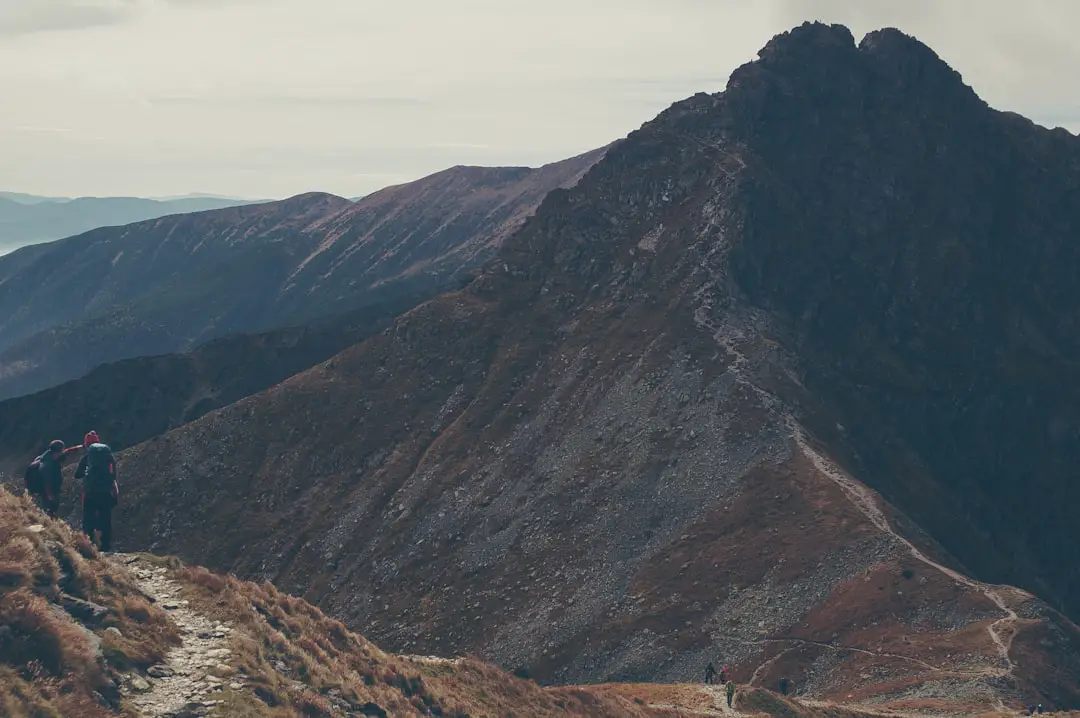Class 3 hiking represents a significant step up from the more straightforward trails classified as Class 1 and Class 2. In the realm of hiking, classifications are essential for understanding the level of difficulty and the skills required to navigate various terrains. Class 3 hiking typically involves scrambling, where hikers must use both their hands and feet to ascend or descend steep, rocky sections.
This type of hiking often requires a greater degree of physical fitness, balance, and coordination compared to lower classes. The terrain can include loose rocks, steep inclines, and exposed areas that may necessitate careful foot placement and handholds. The classification system is designed to help hikers gauge their abilities against the challenges they may face on the trail.
Class 3 trails can vary widely in their specific characteristics, but they generally require some technical skills, such as the ability to navigate rocky outcrops or steep slopes. While not requiring specialized climbing gear like ropes or harnesses, Class 3 hiking does demand a certain level of confidence in one’s climbing abilities. Hikers may encounter sections where they need to pull themselves up using handholds or navigate around obstacles that require careful maneuvering.
Key Takeaways
- Class 3 hiking involves scrambling over steep, rugged terrain that requires the use of hands for balance and support.
- Essential gear for Class 3 hiking includes a helmet, sturdy hiking boots, and a harness for added safety on exposed sections.
- Safety precautions for Class 3 hiking include staying focused, using proper handholds and footholds, and being aware of potential rockfall.
- When choosing a trail for Class 3 hiking, consider the difficulty level, exposure to elements, and the presence of reliable route markers.
- Tips for navigating Class 3 terrain include studying the route beforehand, staying flexible, and communicating with your hiking partners.
The Gear You’ll Need for Class 3 Hiking
When preparing for a Class 3 hike, selecting the right gear is crucial for both safety and comfort. Footwear is one of the most important considerations; sturdy hiking boots with good ankle support and a robust tread pattern are essential for navigating rocky terrain. A pair of boots that fit well and provide traction can significantly reduce the risk of slips and falls on uneven surfaces.
Additionally, some hikers may opt for approach shoes, which offer a balance between hiking boots and climbing shoes, providing flexibility and grip for scrambling. Beyond footwear, other essential gear includes a well-fitted backpack to carry necessary supplies such as water, snacks, and first-aid kits. Hydration systems or water bottles should be easily accessible, as staying hydrated is vital during strenuous hikes.
Depending on the specific trail conditions, trekking poles can also be beneficial; they provide additional stability and support when navigating steep or rocky sections. Furthermore, protective clothing such as moisture-wicking shirts, durable pants, and weather-appropriate outer layers can enhance comfort and safety by shielding against the elements.
Safety Precautions for Class 3 Hiking

Safety should always be a top priority when embarking on a Class 3 hike. One of the most critical precautions is to assess your own skill level honestly. Understanding your physical capabilities and experience with scrambling is essential before tackling more challenging trails.
It’s advisable to start with less difficult Class 3 routes to build confidence and skills before progressing to more demanding hikes. Additionally, it’s wise to hike with a partner or group whenever possible; having companions can provide support in case of an emergency and enhance overall safety. Another important safety measure is to familiarize yourself with the trail conditions before setting out.
Researching the specific route can help you anticipate challenges such as loose rocks or steep drop-offs. Carrying a map or GPS device is also recommended to avoid getting lost in unfamiliar terrain. Moreover, it’s crucial to be aware of weather conditions; sudden changes in weather can make Class 3 hiking significantly more dangerous.
Always check forecasts before heading out and be prepared to turn back if conditions deteriorate.
Choosing the Right Trail for Class 3 Hiking
| Trail Name | Difficulty Level | Distance | Elevation Gain | Scenery |
|---|---|---|---|---|
| Mount Yale | Class 3 | 9 miles | 4,300 feet | Mountain views, alpine lakes |
| Longs Peak Keyhole Route | Class 3 | 14.5 miles | 5,100 feet | Rocky terrain, panoramic views |
| Capitol Peak | Class 3 | 17 miles | 5,300 feet | Exposure, rugged peaks |
Selecting an appropriate trail for Class 3 hiking involves considering several factors, including your experience level, physical fitness, and the specific challenges presented by the trail. Many hiking resources provide detailed descriptions of trails, including their classifications, elevation changes, and notable features. It’s beneficial to read reviews from other hikers who have completed the trail to gain insights into what to expect.
Some trails may have sections that are more challenging than others, so understanding the overall layout can help you prepare mentally and physically. Additionally, consider the geographical location of the trail and its accessibility. Some Class 3 hikes may require longer approaches or involve remote areas that necessitate additional planning for logistics such as transportation and overnight accommodations if needed.
It’s also wise to take into account seasonal factors; certain trails may be more accessible during specific times of the year due to snow or mud conditions. By carefully selecting a trail that aligns with your abilities and preferences, you can enhance your overall hiking experience.
Tips for Navigating Class 3 Terrain
Navigating Class 3 terrain requires a combination of physical skills and mental awareness. One effective strategy is to maintain a low center of gravity while moving through rocky sections; this can enhance stability and balance. When scrambling up steep inclines, it’s often helpful to use your hands for support on solid holds while keeping your feet secure on stable rocks.
Conversely, when descending, it’s crucial to assess each step carefully to avoid slipping or losing balance. Another important tip is to take your time and avoid rushing through challenging sections. Patience is key in Class 3 hiking; hurrying can lead to missteps or accidents.
If you encounter a particularly difficult section, don’t hesitate to pause and evaluate your options before proceeding. Sometimes it may be necessary to backtrack slightly to find a better route or handhold. Additionally, practicing good communication with your hiking companions can help ensure everyone is on the same page regarding pace and safety.
The Physical Demands of Class 3 Hiking

Class 3 hiking presents unique physical challenges that can test even seasoned hikers. The combination of elevation gain, uneven terrain, and the need for upper body strength makes this type of hiking more demanding than lower classifications. As hikers navigate rocky outcrops and steep inclines, they engage various muscle groups, particularly in the legs, core, and arms.
This multifaceted physical engagement can lead to fatigue more quickly than on easier trails. Moreover, cardiovascular endurance plays a significant role in successfully completing a Class 3 hike. The increased effort required for scrambling means that hikers must maintain a steady pace while managing their energy levels throughout the journey.
It’s advisable for those planning to tackle Class 3 hikes to engage in regular physical training that includes strength training, cardiovascular workouts, and flexibility exercises. Building overall fitness will not only enhance performance but also reduce the risk of injury during challenging hikes.
Wildlife Encounters on Class 3 Hikes
Hiking in natural areas often brings opportunities for wildlife encounters, which can be both thrilling and educational. However, when engaging in Class 3 hiking, it’s essential to remain vigilant about potential wildlife interactions. Many trails traverse habitats where animals such as deer, bears, or smaller mammals may be present.
Understanding how to behave in these situations is crucial for both your safety and the well-being of the wildlife. When encountering wildlife on a Class 3 hike, it’s important to maintain a safe distance and avoid approaching animals. Sudden movements or loud noises can startle wildlife, potentially leading to defensive behavior.
Carrying bear spray in areas known for bear activity is advisable as a precautionary measure. Additionally, being aware of animal tracks or signs along the trail can enhance your experience by providing insights into the local ecosystem while ensuring you remain cautious.
The Mental Challenge of Class 3 Hiking
The mental aspect of Class 3 hiking is often as demanding as the physical challenges presented by the terrain. Scrambling over rocks and navigating steep inclines requires focus and concentration; distractions can lead to missteps or accidents. Developing mental resilience is essential for overcoming obstacles encountered on these trails.
Hikers must cultivate a mindset that embraces challenges while remaining adaptable in the face of unexpected difficulties. Visualization techniques can be beneficial for preparing mentally for a Class 3 hike. Before embarking on the journey, take time to visualize yourself successfully navigating challenging sections of the trail.
This mental rehearsal can boost confidence and reduce anxiety about potential obstacles. Additionally, practicing mindfulness during the hike—focusing on your breath and surroundings—can help maintain concentration and enhance enjoyment of the experience.
How to Prepare for Class 3 Hiking
Preparation is key when it comes to successfully completing a Class 3 hike. Start by conducting thorough research on your chosen trail; familiarize yourself with its specific challenges and requirements. Understanding the route will allow you to mentally prepare for what lies ahead while also helping you pack appropriately based on expected conditions.
Physical preparation should not be overlooked either; engaging in regular exercise that builds strength and endurance will significantly enhance your ability to tackle Class 3 terrain. Incorporating activities such as rock climbing or bouldering into your training regimen can also improve your scrambling skills while building confidence in your abilities. Additionally, practicing navigation skills using maps or GPS devices will ensure you feel comfortable finding your way through unfamiliar areas.
The Rewards of Class 3 Hiking
The rewards of embarking on a Class 3 hike extend far beyond simply reaching the summit or completing a challenging trail; they encompass personal growth, connection with nature, and unforgettable experiences. Successfully navigating difficult terrain fosters a sense of accomplishment that can boost self-esteem and confidence in one’s abilities. Each scramble over rocks or ascent up steep inclines becomes a testament to perseverance and determination.
Moreover, Class 3 hikes often lead to breathtaking vistas that are less accessible than those found on easier trails. The effort expended in reaching these remote locations is often rewarded with stunning views that showcase nature’s beauty in its rawest form. These moments spent in awe-inspiring landscapes create lasting memories that enrich one’s appreciation for the outdoors.
Exploring Class 3 Hiking Destinations
There are numerous destinations across various regions that offer exceptional Class 3 hiking experiences. For instance, in the United States, locations like Mount Whitney in California provide challenging routes that attract adventurous hikers seeking stunning views from high altitudes. The approach involves navigating rocky terrain that requires both skill and determination.
In contrast, destinations like the Grand Teton National Park in Wyoming offer diverse Class 3 routes that cater to different skill levels while showcasing dramatic mountain scenery. The combination of rugged landscapes and opportunities for wildlife encounters makes these areas particularly appealing for those looking to immerse themselves in nature while testing their limits through Class 3 hiking adventures. Exploring international destinations also opens up exciting possibilities for Class 3 hiking enthusiasts.
The Dolomites in Italy present breathtaking views alongside challenging scrambles that attract climbers from around the world seeking both adventure and beauty in their outdoor pursuits. Each destination offers unique challenges and rewards that contribute to the rich tapestry of experiences available through Class 3 hiking adventures worldwide.
If you’re planning a class 3 hiking adventure, you may also be interested in checking out this article on the best sleeping bag for backpacking travel here. Having the right gear is essential for a successful hiking trip, and a quality sleeping bag can make all the difference in ensuring a good night’s rest after a long day on the trails.
FAQs
What is class 3 hiking?
Class 3 hiking refers to a type of hiking that involves scrambling over rocks and steep terrain, where the use of hands for balance and support is often necessary. It is more challenging than class 1 and class 2 hiking, but does not require the use of ropes or technical climbing equipment.
What are the characteristics of class 3 hiking?
Class 3 hiking typically involves steep and exposed terrain, with the need for handholds and footholds to navigate through rocky sections. It may also include some exposure to heights and require careful route finding.
What kind of experience and skills are needed for class 3 hiking?
Class 3 hiking requires hikers to have a good level of physical fitness, as well as experience in hiking and navigating through challenging terrain. Basic rock scrambling skills and the ability to assess and manage risk are also important for class 3 hiking.
What gear is recommended for class 3 hiking?
For class 3 hiking, it is recommended to wear sturdy hiking boots with good traction, as well as a helmet for protection against falling rocks. Hikers may also benefit from using trekking poles for added stability and carrying a small daypack with essentials such as water, snacks, and a first aid kit.
Are there any specific safety considerations for class 3 hiking?
Safety is paramount in class 3 hiking, and hikers should always assess the risks and be prepared for the challenges of the terrain. It is important to stay focused, use proper handholds and footholds, and be mindful of potential rockfall. Additionally, hikers should be aware of weather conditions and have a plan for emergencies.
